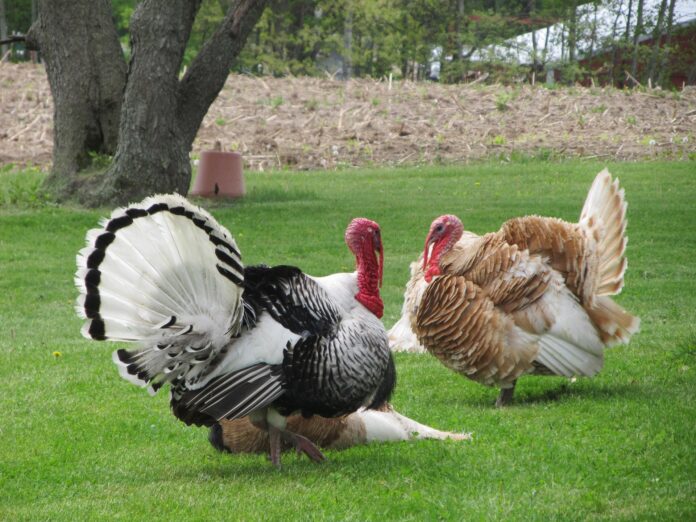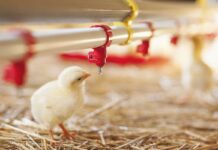
Salmonella is a foodborne zoonotic pathogen prevalent in poultry production, including turkeys. The pathogen is a constant threat to human public health because of its potential to cause outbreaks involving illness cases, hospitalizations, and deaths.
Shijinaraj Manjankattil BVScAH, MS, Claire Peichel MS, Grace Dewi MS, and Anup Kollanoor Johny BVScAH, MVSc, PhD – Department of Animal Science, University of Minnesota – Twin Cities
The problem of Salmonella in turkey production
Poultry is a significant source of clinical, non-clinical, and antibiotic-resistant variants of Salmonella. Salmonella colonized in the cecum of turkeys and disseminated to the internal organs are considered a potential food safety hazard through products. Appropriate management practices and antimicrobial interventions during the preharvest phase can effectively control Salmonella and improve postharvest control of the pathogen. Moreover, the emergence of drug-resistant Salmonella in production environments has necessitated antibiotic stewardship as a responsibility of the turkey producers and integrators. The USDA recommends nonantibiotic interventions such as vaccines, prebiotics, probiotics, and organic acids in production. Although individual interventions have proven benefits, shifts in the dynamics of predominant serotypes encountered on farms, new serotypes emerging with more invasive capabilities, and multiple serotypes potentially colonizing in turkey gut demand innovative and broad approaches for Salmonella control. Our lab investigates several nonantibiotic interventions for the preharvest safety of turkeys, of which updated research is briefly presented in this document.
Non-host derived probiotics for Salmonella reduction
Several probiotics are investigated for their potential in pathogen control independently and in combinations through various commercial preparations. However, consistency in results is an essential determining factor for industry application. Our laboratory investigates a non-host derived probiotic, Propionibacterium freudenreichii subsp. freudenreichii, a dairy origin GRAS-status bacteria commonly used in cheese production, for its activity against Salmonella in turkeys. The bacterium shows antibacterial activity against many foodborne pathogens like Escherichia coli and Listeria monocytogenes. Previous studies from our lab showed that Propionibacterium freudenreichii subsp. freudenreichii can reduce multiplication, motility, cell association, and invasion of three major Salmonella serotypes in poultry. The probiotic potential of Propionibacterium freudenreichii subsp. freudenreichii in turkeys was also tested by determining factors like its resistance to gastric pH and bile salts, hemolytic activity, invasive characteristics, and antibiotic susceptibility. The results from this study indicated that the probiotic is tolerant to low pH and bile salts with no hemolytic activity and invasive properties noted. In the in vivo studies, Propionibacterium freudenreichii subsp. freudenreichii was tested against Salmonella enterica Heidelberg in three different age groups. In these studies, turkeys were supplemented with the probiotic through drinking water. A reduction of 1.6 to 2.2 log10 of Salmonella enterica Heidelberg was obtained in the probiotic-supplemented groups compared to the positive control when bacteria were recovered at two weeks of age. Studies using turkey challenge models at the age of week 7 showed promising results in preventing invasion of Salmonella enterica Heidelberg to the spleen and liver. Only 37.5 % of liver and spleen samples were positive in Propionibacterium freudenreichii subsp. freudenreichii treated groups compared to the 87.5 % positive samples in the control group. Studies with finisher turkeys at 12 weeks of age indicated a 2 to 2.6 log10 reduction in Salmonella enterica Heidelberg populations in the cecum of probiotic-supplemented turkeys compared to the control groups. Cecal microbiome studies in turkeys revealed that supplementation of Propionibacterium freudenreichii subsp. freudenreichii could modify microbial flora by increasing the carbohydrate fermenting and short-chain fatty acid- producing bacteria in the gut of turkeys.
Host-derived probiotics for Salmonella control
Although several host-derived probiotics are investigated for their many benefits in the hosts, Lactobacillus species attracts special mention due to their historical safety margin and health benefits evident in animals and humans. Among the several species of Lactobacillus, Lactobacillus salivarius was investigated as a competitive exclusion bacterium against Salmonella enterica Enteritidis, Salmonella enterica Typhimurium, and Salmonella enterica Kentucky in the cecum of chickens. A dose of 106 to 108 log Lactobacillus salivarius through oral gavage was found to reduce 2 to 2.5 log10 Salmonella in the cecum of chickens. Pascual et al. (1999) demonstrated that a single oral gavage with 108 Lactobacillus salivarius could result in 100% Salmonella-free chickens at 21 days post-inoculation. However, the authors recommended multiple doses per their observation that the Lactobacillus populations significantly diminishes between 21- and 28-days post-inoculation.
Lactobacillus salivarius is also known for improving body weight, intestinal morphometry, and intestinal integrity in turkey poults. Lactobacillus salivarius was used to ferment soybean meal in the turkey diet and fed prophylactic and therapeutic regimens after a Salmonella enterica Typhimurium challenge. It was found that fermented soybean meal with Lactobacillus salivarius increased villi length, villus surface area, villus crypt ratio, and crypt depth. Recent studies from our lab had reported a significant reduction in multidrug-resistant Salmonella enterica Heidelberg in the cecum of turkeys when a combination of Lactobacillus salivarius UMNPBX2 and Lactobacillus Ingluviei UMNPBX19 was supplemented through drinking water. Additionally, Peichel et al. (2021b) recently reported the antibacterial activity of Lactobacillus salivarius UMNPBX2 against outbreak causing Salmonella enterica Reading isolates in turkeys.
Vaccines for Salmonella control
Vaccination has been historically used to prevent several human and animal diseases. They work on the principle of developing immunity in the host. Vaccination is a promising pre-harvest strategy to control Salmonella in turkey flocks. A commercially available, USDA-approved Salmonella vaccine (AviPro Megan Egg, Elanco), containing live cultures of Salmonella enterica Typhimurium, is approved for turkeys. It is effective against Salmonella enterica Typhimurium in turkeys when vaccinated at day 1 of age and followed by revaccination at week 3 of age. However, studies on cross-protection to other serovars and the duration of immunity are limited in turkeys. Recently, Peichel et al. (2021) reported cross-protection of AviPro Megan egg vaccine against Salmonella enterica Reading in three different age groups of turkeys. Approximately 2 log10 reductions of Salmonella in the cecum and significantly fewer Salmonella positive liver, spleen, and crop samples indicate its cross protectivity against an emergent and drug- resistant clone of Salmonella enterica Reading.
Studies on AviPro Salmonella Duo containing metabolically mutant strains of Salmonella enterica Typhimurium and Salmonella enterica Enteritidis showed that it could reduce Salmonella colonization in the cecum and invasion to internal organs. The researchers also found high antibody titers in turkeys receiving multiple boosters. Similarly, studies on the clearance of vaccine strain showed that it is more likely to re-isolate both Salmonella enterica Enteritidis and Salmonella enterica Typhimurium vaccine strains until day 14 of vaccination after the first dose. But with each booster dose, re-isolation was reduced as antibody titers increased. Similarly studies investigating BBS 866, a live attenuated Salmonella enterica Typhimurium vaccine, proved to provide cross-protection against Salmonella enterica Heidelberg in turkeys.
Ongoing Investigations
As discussed earlier, preharvest interventions using probiotics and vaccines have been proven to have independent antibacterial effects against multiple Salmonella serovars. A potentially enhanced activity exists if these interventions are used in combinations, especially against the outbreak causing Salmonella strains in turkey production. In a recently completed study from our lab, Dewi et al. (2021) used a combined and targeted approach using turkey-derived Lactobacillus strains and an essential oil ingredient, trans cinnamaldehyde against Salmonella enterica Heidelberg in turkey poults. This combination treatment resulted in more than 2.5 log10 Salmonella enterica Heidelberg in the cecum compared to a lower magnitude of reduction obtained from individual treated groups. In another study from our lab, Peichel et al. (2021) combined Lactobacillus salivarius with Salmonella Typhimurium vaccine for enhanced benefits in turkeys. These results suggest more studies on choosing targeted combination approaches against Salmonella in turkey production. Currently, our lab group is testing the combined effect of probiotics and vaccines against other emerging Salmonella serovars in turkey production. We are also invested in understanding better the mechanisms of action of the combination approaches using molecular approaches.
Acknowledgments
The authors of this article would like to thank funding sources supporting these studies, including the MnDRIVE GFV graduate fellowship 2020-2021 awarded to Shijina and Claire, Minnesota Agricultural Experimentation Station Project #MIN-16-120; Minnesota Turkey Research and Promotion Council Grant #2019-02; Minnesota Department of Agriculture Rapid Response Grant FY 20-22; USDA NIFA Hatch Accession #1016910; USDA AFRI #2018-68003-27464; and USDA NIFA #2020-67017-30787. The authors also acknowledge Drs. Timothy Johnson, Sally Noll, Carol Cardona, Zata Vikers, Petri Papinaho, and Ryan Cox for their collaboration and/or contribution in these projects.
References are available on request
From the Proceedings of the Midwest Poultry Federation Convention 2022

















